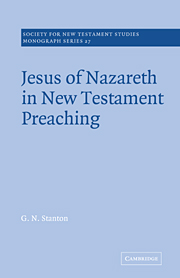Book contents
- Frontmatter
- Contents
- Preface
- Abbreviations
- Introduction
- 1 Jesus of Nazareth in missionary preaching: Luke's view
- 2 Luke's presentation of Jesus in his Gospel
- 3 Pre-Lucan traditions about Jesus in the speeches in Acts
- 4 Jesus in Paul's preaching
- 5 The gospels and ancient biographical writing
- 6 Jesus in the gospel traditions
- 7 The gospel traditions in the early church
- Conclusions
- Index of passages cited
- Index of authors
- General Index
6 - Jesus in the gospel traditions
Published online by Cambridge University Press: 04 October 2009
- Frontmatter
- Contents
- Preface
- Abbreviations
- Introduction
- 1 Jesus of Nazareth in missionary preaching: Luke's view
- 2 Luke's presentation of Jesus in his Gospel
- 3 Pre-Lucan traditions about Jesus in the speeches in Acts
- 4 Jesus in Paul's preaching
- 5 The gospels and ancient biographical writing
- 6 Jesus in the gospel traditions
- 7 The gospel traditions in the early church
- Conclusions
- Index of passages cited
- Index of authors
- General Index
Summary
In the last two decades there have been several impressive attempts to show that the main outlines of the teaching of Jesus can be reconstructed by the modern historian: the outstanding authority with which Jesus taught, as well as the distinctiveness of much of his teaching, have been underlined most effectively. The so-called new quest for the historical Jesus has shown that we can know rather more about the historical Jesus than R. Bultmann had supposed and that the gap between the historical Jesus and the kerygma is not as wide as many had accepted. But most of the scholars associated with the new quest have accepted R. Bultmann's insistence that material in the gospels which is useful for the modern historian's reconstruction of the historical Jesus has survived against the primary intention of the traditions themselves. The gospel traditions were not intended to be ‘reports’ about Jesus; they are not concerned with the ‘past’ of the historical Jesus, but belong to the church's proclamation of the Risen Christ.
A rather different approach is proposed in this chapter and in the chapter which follows: the gospel traditions which the church retained and used were intended, as one of their purposes, to sketch out the life and character of Jesus.
Some parts of the traditions which tell us a good deal about the character of Jesus, especially by recording his relationships with others, will be examined.
- Type
- Chapter
- Information
- Jesus of Nazareth in New Testament Preaching , pp. 137 - 171Publisher: Cambridge University PressPrint publication year: 1975



